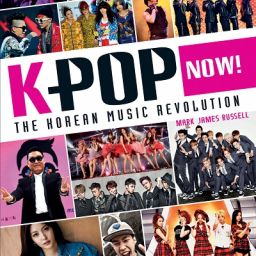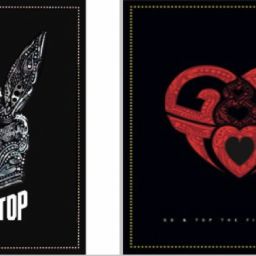by Miranda Ruth Larsen
During the 2015 edition of KCON Los Angeles (the West coast half of the annual Korean culture and music con) fans watched looped display ads as they waited in line for meet and greet sessions with Korean artists.
Boy band GOT7’s just-released smash hit “Just Right” played repeatedly during a thirty-second promotional spot for the new app, V (also known as V:Live), which touts itself as a “real-time celeb broadcasting app” ([Teaser]). Backed by South Korean media powerhouse Naver, V is a mostly free app available on iOS and Android devices that connects fans to K-pop stars.

Though the success of Hallyu, or the Korean Wave, the term used for the worldwide popularity of Korean popular culture, and Korean artists have gone beyond Asia for tours and promotional events and access to Korean artists remains difficult. Many fans want to reach out to idols beyond social media engagement (Twitter, Facebook, Line) and official content (music videos, concert DVDs, CDs).
V fills some of this gap between social media interaction and officially released content by meshing the two, and its marketing at KCON is of course no accident, as the first artists to open channels on V were the artists performing at KCON that year.
V illustrates scholar Dal Yong Jin’s argument that “while the swift process of globalization has led to an increase in transnational cultural practices among global fans of Korean popular culture, alternative cultural resources from Korea made available through digital technologies and social media allow these global fans to enjoy local culture, both popular culture and digital culture, which differentiates the New Korean Wave not only from Hallyu 1.0 but also from other non-Western countries transnational cultural power” (Jin, 166-167)
V has undergone interface changes and feature upgrades since its debut, but the core appeal of the platform remains the same. As of September 2016, over 256 different channels exist for artists and labels. The current incarnation of the app allows users to ‘favorite’ the channels of different K-pop artists, view archived broadcasts on those channels, and most importantly participate in live broadcasts.
V’s wealth of content also deserves mention. From reality-style shows to five-minute backstage greetings, artists utilize V to connect with fans in a wide range of situations. While the boy band HISTORY filmed themselves bowling for fun, boy band B.I.G (AKA Boys in Groove) broadcasted their own reactions to watching their completed music video for “Aphrodite” while fans commented rapidly. Production values, sound quality, and technical finesse all vary; broadcasts have ended prematurely because of hitting the wrong button, poor connections, or locations with too much feedback noise. This adds a sense of verisimilitude often lacking in the prepackaged world of K-pop, a stylization of the behind-the-scenes aesthetic.
During live broadcasts users can comment (though some language is censored), and repeatedly press a ‘heart’ button to show the artist some love, which pops up in the middle of the screen and partially obscures the broadcast. Users frequently encourage each other to tap the heart button as fast as possible, garnering huge numbers of hearts even when actual viewing screens are few. Tuning in to a particular artist’s live broadcasts when they start, sharing the broadcast link, commenting, and heart-ing all increase a user’s “chemi-beat” with that artist, an essential ranking of top participating fans though the algorithm is often questioned.
As of September 2016, V currently states on the Apple’s app store that they “plan to provide benefits to active users who enthusiastically participate in the activity”. Currently fans can only interact with each other through the commenting function on live or archived broadcasts, though the potential exists to graft other social networking aspects onto the app with the chemi-beat listings problematically functioning as social capital standings. The comments linger even after the live broadcast ends, so fans are able to scroll back through the comments and see how other fans reacted when the video aired in real time.
V offers a massive amount of potential for both artists and fans to connect with each other. Broadcasts range anywhere from a few minutes to over an hour long. Some channels have massive amounts of content (like boy band BTS (AKA Bangtan Boys)), whereas newcomers like B.I.G and HISTORY have only recently begun posting videos and holding live broadcasts. Live broadcasts offer fans around the world an opportunity for recognition by their favorite artists; in many broadcasts, K-pop stars regularly read usernames and answer prompts like “say hello” or “say I love you” to the camera. The openness of the platform allows artists to engage with their global fanbase, while fans often write comments in their own language(s) and Korean in order to guarantee understanding. As some groups have designated members skilled in foreign languages (especially English and Japanese), writing comments in those languages can flag the attention of particular members. Linguistic differences aside, the more popular broadcasts generate comments too fast for artists and other fans to read properly. The comment screen also partially obscures the actual broadcast content when the content is maximized to full screen, prompting many users to abandon reading the comments altogether so as to better see the artists.
V maintains an active Twitter account promoting scheduled broadcasts and now paid content, notably in English. Mostly, artists speak in Korean, and occasionally subtitles are available for broadcasts, though it depends on the packaging of the content. Subtitles are usually in English or Japanese, reflecting the wealth of fan comments in these two languages. Comments flood the screen when artists respond to fan prompts, or when something unexpected happens; language (and interestingly, the music itself) become secondary concerns.
The fascinating thing about V is that despite that most live broadcasts having no subtitles, fans often can’t communicate in Korean, and yet the level of immediacy and intimacy are palpable.
Content is also generated based on the artist’s schedule, so fans in distant locations have to wake up in the middle of the night or attempt to adjust their daily schedule in order to participate in a live broadcast. A calendar feature allows users to see upcoming scheduled broadcasts and set a reminder alarm on their mobile device about tuning in on time. Last-minute additions to the calendar are also common, and artists frequently broadcast randomly, so keeping an eye on the app is crucial. Allowing the app to send alerts for certain artists results in a chiming phone every time a new broadcast begins. For many fans this becomes taxing, as some artists broadcast almost every other day, while others only upload prepackaged, official videos with no possibility of interaction.
Two trends points towards V’s growing importance in the K-pop market: the introduction of paid content, and the usage of the platform for music video debuts. Some artists have premiered official content like music videos on V before uploading to YouTube, such as BTS’ release of “Fire”’s dance version video which was exclusively available on V for several days. As K-pop videos often have multiple versions for the same song, releasing a video on V drives a massive flow of fans towards the platform as word circulates. Oftentimes V broadcasts are then uploaded to YouTube either officially through artist channels (once enough fan outpouring has come to their attention) or unofficially by fans wishing to share the content with others.
Since V requires the use of cellular data or a wi-fi connection, the app is heavy on data usage and connections can be unstable or simply unfeasible for large numbers of fans. V-exclusive debuts of content therefore activate more links within fandom, as those with access often rip and distribute the content to those unable to use the platform. It also cements V’s position as an important link in the K-pop machine, as even fans without access to the app are aware of what content appears on it when they encounter it secondhand on YouTube or in a news posting on Twitter.
In the last few months V has introduced a ‘coins’ feature, injecting real-life capital into the previously free application. Users can pay coins to watch exclusive content such as BTS’ reality show about traveling unaided, or boy band EXO’s documentary, for example. Since it is likely in the future that somewhere the chemi-beat and coins features will link (active users will probably receive coin bonuses), this changes the dynamic of the app.
A big element of K-pop’s worldwide success is its immediate availability; artists frequently release to iTunes and make their music videos available via YouTube, except in the case of releases in the Japanese market, which are still much more tied to CDs (Galbraith and Karlin 4). Switching V from an essentially free (aside from data costs) app to one with both social and market capital involved constructs a microeconomy within a previously open fan-friendly space.
Similarly, the chemi-beat system invites competitiveness; at present one can only access the usernames and profile photos of the top 20 fans of any particular channel. Rather than forming a global community centered around the same musical tastes with naturally occurring flows and frictions, the chemi-beat system seems to actively promote division and hierarchical fracturing as fans compare themselves to one another.
The variations of participation with V for both fans and artists makes it a fascinating terrain in terms of fandom; V’s attempts to measure engagement and symbolize fandom through a heart-shaped button speaks volumes as to the platform’s functionality as somewhere in-between social media and official content.
Since V’s comments are in some ways regulated (attempting to write certain words, like ‘sexy,’ results in the response “This comment cannot be posted”), and the volume of comments often makes it difficult for artists to actually engage with the content of them, joining a V broadcast often becomes about co-presence and madly tapping the heart button. This of course still has value and plays an integral part in the appeal of many of these artists to both new and longtime fans, yet it seems that V is trying to do too many things at once all linked to the importance of the live broadcast.
In a genre like K-pop predicated on star potential and access, V offers a playground of content with a heavy focus on fans viewing simultaneously – different from the usual experience of hunting through a flow of YouTube recommendations, for example. The platform is attempting to answer the core of Hallyu – overseas appeal, intimacy for fans, and cutting edge technology. As JungBong Choi contends, “Hallyu as a transnational cultural phenomenon is profoundly dependent on the cultural masonry carried out by a legion of under-recognized ‘craftsmen,’ namely, overseas fans” (Choi 41). Though V will undoubtedly undergo more aesthetic and formal changes, the app will continue to impact K-pop fans around the world as they interact with artists and each other.
Sources:
Choi, JungBong. “Hallyu versus Hallyu-hwa: Cultural Phenomenon versus Institutional Campaign” in Hallyu 2.0: The Korean Wave in the Age of Social Media, eds. Sangjoon Lee and Abe Mark Nornes. Ann Arbor: University of Michigan Press, 2015.
Galbraith, Patrick W. and Jason G. Karlin. “Introduction: At the Crossroads of Media Convergence in Japan.” Media Convergence in Japan. Tokyo: Kinema Club, 2016.
Jin, Dal Yong. New Korean Wave: Transnational Cultural Power in the Age of Social Media. Chicago: University of Illinois Press, 2016.
“[Real Live V] Highlight No. 3 – ENG” V Live Channel. 10 Aug 2015. <https://youtu.be/wZGGS5y2LO4>
“[Teaser] real live V app with GOT7 (갓세븐)” V Live Channel. 6 Aug 2015. <https://youtu.be/2dtQKZ2L-NQ>
Miranda Ruth Larsen is a PhD student at the University of Tokyo. Her research focuses on the transcultural appeals of masculinities in Japanese and Korean popular music. She has been tinkering with the V app since its debut at KCON 2015. She previously wrote for TLF’s Seminar Series about the Japanese boy group KAT-TUN.







